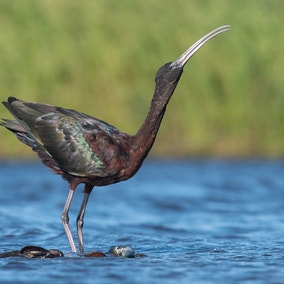Bird Guide
Guide to North American Birds
Explore more than 800 North American bird species, learn about their lives and habitats, and how ÃÛèÖAPP change is impacting their ability to survive.
4 birds


! Priority Bird
Roseate Spoonbill
Platalea ajaja
Ibises and Spoonbills
At a Glance
Gorgeous at a distance and bizarre up close is the Roseate Spoonbill. Locally common in coastal Florida, Texas, and southwest Louisiana, they are usually in small flocks, often associating with other waders. Spoonbills feed in shallow waters, walking forward slowly while they swing their heads from side to side, sifting the muck with their wide flat bills.
Conservation Status
Least Concern
Habitat
Coasts and Shorelines, Freshwater Wetlands, Lakes, Ponds, and Rivers, Saltwater Wetlands


White Ibis
Eudocimus albus
Ibises and Spoonbills
At a Glance
One of the most numerous wading birds in Florida, and common elsewhere in the southeast. Highly sociable at all seasons, roosting and feeding in flocks, nesting in large colonies. When groups wade through shallows, probing with their long bills, other wading birds such as egrets may follow them to catch prey stirred up by the ibises.
Conservation Status
Least Concern
Habitat
Coasts and Shorelines, Fields, Meadows, and Grasslands, Freshwater Wetlands, Lakes, Ponds, and Rivers, Saltwater Wetlands


Glossy Ibis
Plegadis falcinellus
Ibises and Spoonbills
At a Glance
Flocks of Glossy Ibises wade in the shallows of eastern marshes, probing for food with their sickle-shaped bills. Widespread in the Old World, the species is found in the New World mainly in the West Indies and along our Atlantic Coast, especially Florida, where it was quite scarce as recently as the 1930s. It may have invaded within the last few centuries, riding the trade winds across from West Africa to the Caribbean.
Conservation Status
Least Concern
Habitat
Coasts and Shorelines, Fields, Meadows, and Grasslands, Freshwater Wetlands, Lakes, Ponds, and Rivers, Saltwater Wetlands


White-faced Ibis
Plegadis chihi
Ibises and Spoonbills
At a Glance
Very similar to the Glossy Ibis, and mostly replaces it west of the Mississippi River, although the two species occur together in parts of the southeast. White-faced Ibises wander through the west during the warmer months, and they may quickly find and take advantage of temporary new habitat after rains or flooding. Even their nesting sites often change from year to year with changes in local water levels.
Conservation Status
Least Concern
Habitat
Coasts and Shorelines, Fields, Meadows, and Grasslands, Freshwater Wetlands, Lakes, Ponds, and Rivers, Saltwater Wetlands